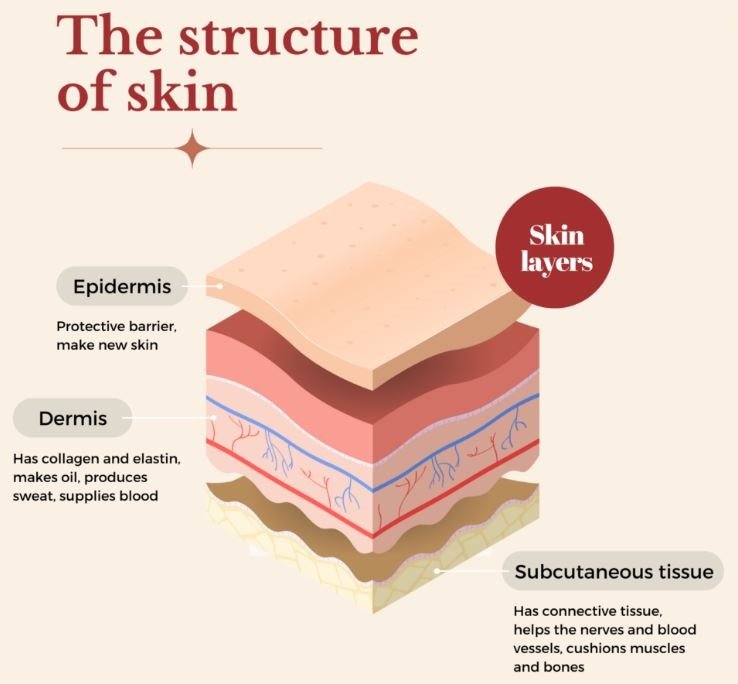Basic knowledge of skin
In order to manufacture detergents and cosmetics used for the human body, it is recommended to be familiar with the basic knowledge of the skin. Skin acts as a natural barrier to protect the human body from physical, microbial and chemical stimuli. It is the most significant skin covering the body surface and can be divided into three layers: epidermis, dermis, and subcutaneous tissue from the outer layer. It is an accessory organ composed of hair, sebaceous glands, sweat glands, and capillaries. In particular, the skin is composed of the widest structure in our human body, and weight of the skin accounts for about 16% of the body weight, and it is responsible for 13% of breathing besides the nose and mouth.
1. Human skin structure and function
1) Skin structure
* Epidermis
It is covered with the outermost layer of the skin among the three layers of the skin, and the epidermis is the thinnest, toughest, and hardest of all cells, and plays an important role in moisturizing and protecting the skin, defending against tissue loss and damage, prevent intrusion;
* Dermis
It constitutes the main body of the skin and occupies most of the skin (about 90% or more) with a thick layer of about 15 to 40 times the thickness of the epidermis. do.
The three major components of Dermis are collagen, elastin, and hyaluronic acid.
1- papillary layer
– Papillary projections are small ark-shaped, with blood vessels and the nervous system protruding toward the epidermis.
– It is especially developed in the skin of the nose and tongue.
2- reticular layer
– It is an elastic fibrous tissue as an extension of the papillary layer.
– Consists of fat cells, blood vessels, nerves, lymphatic vessels, hair follicles, and sweat glands.
– Collagen and elastin in the dermis play an important role in skin elasticity (wrinkles).
2) Subcutaneous Tissue
It is a tissue that is located inside the dermis and contains a large amount of fat and plays a role in being able to withstand external pressure such as blood vessels, lymphatic vessels, and nerves.
3) Skin function
The largest function of the skin is protection, protecting internal organs from external influences, adapting the body’s actions to surrounding changes, always being connected to the internal actions of the body, and playing an important role in maintaining life.
– Protective action: The skin acts as a natural barrier to protect the human body from physical, microbial and chemical stimuli, and the invasion of bacteria in the body can be prevented when the skin is healthy and perfect. In addition, since the skin surface is weakly acidic (pH 4.5 ~ 6), excessive contact with acid tends to cause damage to the depths because proteins are dissolved.
– Sensory Action: The skin sensitively senses and perceives.
– Excretory or secretory Action: Body wastes and sodium are excreted through sweat, and the sebum secreted from the sebaceous glands creates a thin layer of fat on the skin surface to prevent moisture from entering and secretes sebum to make the skin smooth.
– Heat Regulation Action: Maintains a constant body temperature by controlling heat dissipation by perspiration or expansion and contraction of skin blood vessels in accordance with changes in the environment or ambient temperature.
– Respiration: About 13% of the human body breathes besides the nose and mouth, and this is called skin respiration.
– Production and absorption of vitamin D: UV rays activate vitamin D substances in the skin. However, these days, diseases caused by vitamin D deficiency are emerging as a big social problem. According to a recent report, about 30% of young people and 40% of people in their 50s and older have confirmed vitamin D deficiency symptoms in winter. In Canada, on average, the winter period is long, so it’s better to be extra careful.
– Immunity: Langerhans cells in the epidermal spinous layer act as immunity.
-The Nature Atelier-
If my article was helpful, please comment and visit my SNS. It will be a great help for me to continue running the site.
Twitter
https://twitter.com/Atelier_Eden
Instagram
https://www.instagram.com/the.natureatelier
